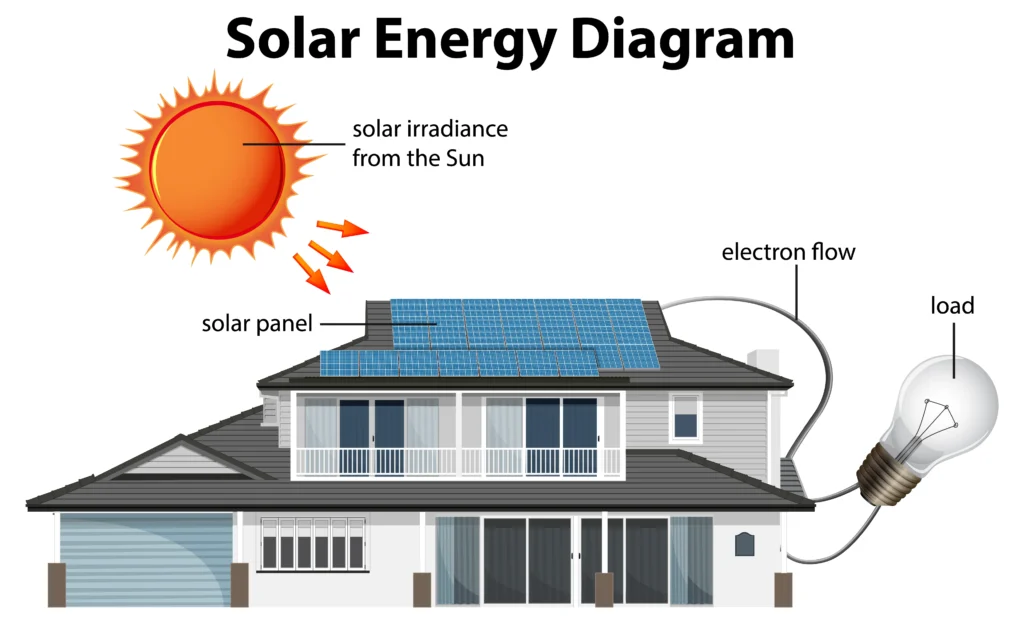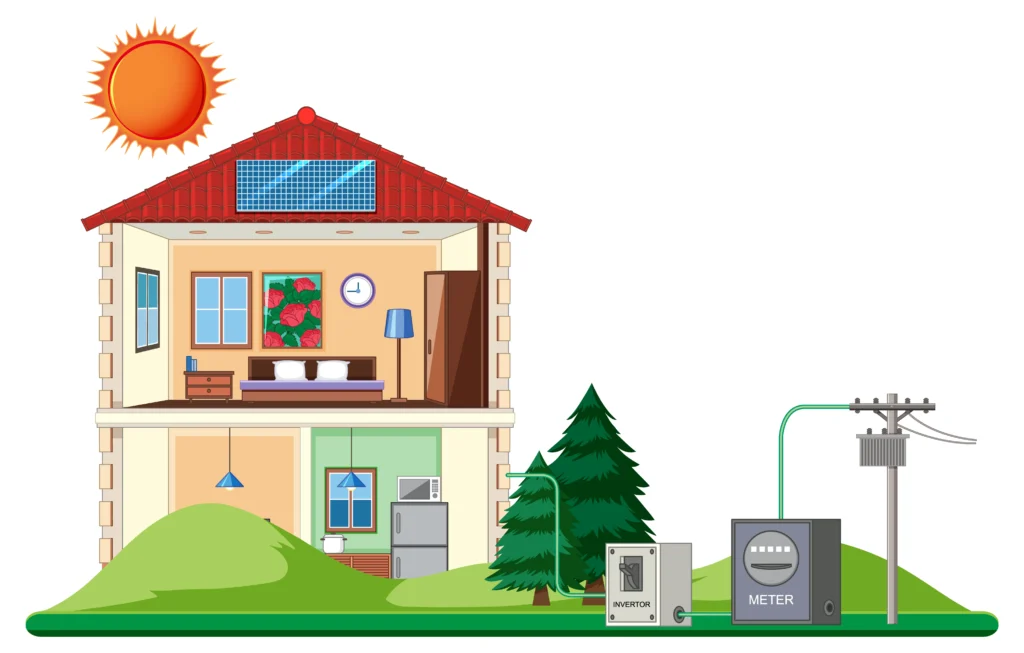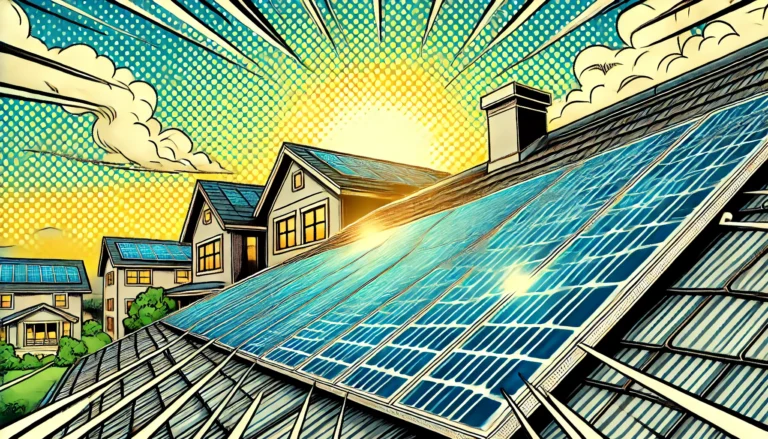Table of contents

- For UK and EU Residents
- High-Quality Solar Solutions
- Expert Guidance & Support
- Sustainable & Cost-Effective
Introduction
How do solar panels work? These clean, renewable energy systems convert sunlight into electricity, helping to power homes, commercial buildings, and off-grid setups. Understanding their science is key to maximizing efficiency and sustainability.
Using the photovoltaic effect, solar panels convert sunlight into electricity, providing a reliable and eco-friendly energy source. This guide breaks down everything you need to know, from how solar cells generate power to optimizing efficiency and storage.
In this article, we’ll cover:
- The science behind photovoltaic cells and how they generate electricity.
- The key components of a solar panel system and their functions.
- How solar power is transmitted and stored for use in homes and businesses.
- The factors that influence solar panel efficiency.
- The various applications of solar energy, from residential setups to commercial and off-grid systems.
Whether you’re looking to cut energy costs or embrace sustainability, this guide will help you understand how solar panels work and their many benefits.

- For Residents of the USA
- Premium Solar Technology
- Tailored Renewable Solutions
- Sustainable & Affordable
What Are Solar Panels and How Do They Work?
Solar panels convert sunlight into electricity through a process known as the photovoltaic effect. These panels are made up of solar cells that capture sunlight and turn it into usable energy. The cells, typically made from silicon, absorb sunlight and release electrons, generating an electric current.
Key Points:
- Definition: Solar panels contain photovoltaic cells that convert sunlight into electricity.
- Photovoltaic Effect: When sunlight hits the solar cells, it knocks electrons loose from atoms in the silicon, creating an electric field that generates direct current (DC) electricity.
- Direct Current (DC): The solar cells produce DC electricity, which needs to be converted into alternating current (AC) for use in homes and businesses.
- How It Powers Homes: An inverter converts DC into AC, allowing it to power household appliances. Excess energy is either stored in a solar battery or sent back to the grid using net metering, which can lower your electricity bills.
By actively harnessing sunlight, solar panels provide a sustainable and cost-effective way to generate electricity and reduce reliance on traditional energy sources.
The Science Behind Photovoltaic Cells
At the core of every solar panel are photovoltaic cells, which convert sunlight into electricity. These cells rely on the photovoltaic effect, a process that allows light energy to turn into electrical energy.
The following table outlines the key steps involved in the photovoltaic effect:
| Step | Process | Description |
| 1. Absorption of Sunlight | Photons (light particles) hit the solar cells, which are typically made from silicon. | The solar cell absorbs energy from the sun in the form of photons. |
| 2. Release of Electrons | Photons knock electrons loose from the atoms in the silicon material. | This process frees up electrons within the silicon, creating an electric field within the cell. |
| 3. Creation of Electric Field | The electric field forces electrons to move, creating an electric current (DC). | The electric field forms between the layers of positive and negative charges in the silicon cell. |
| 4. Generation of Direct Current (DC) | The movement of electrons generates direct current (DC) electricity. | The DC electricity flows through the system, ready to be converted. |
| 5. Conversion to Alternating Current (AC) | An inverter converts the DC electricity into AC, which is used in homes. | The inverter changes the DC power into alternating current (AC), which is compatible with household devices. |
Photovoltaic Cell Efficiency
Several factors, such as the quality of silicon, the amount of sunlight, and proper maintenance, impact the efficiency of photovoltaic cells. Monocrystalline and polycrystalline cells help improve efficiency and maximize energy output.
By capturing sunlight and converting it into electricity, solar panels can either power homes and businesses immediately or store the energy in a solar battery for use at night or during cloudy days.
For a more in-depth look at the science behind solar energy and its benefits, explore the Energysage solar energy guide.

Solar Panel Components Explained
A solar panel system uses several key components to capture sunlight and convert it into electricity. These components work together to ensure the system operates efficiently and delivers clean energy to your home or business.
| Component | Function | Example/Type | Additional Notes |
| Solar Cells | Solar cells absorb sunlight and convert it into direct current (DC) electricity through the photovoltaic effect. | Monocrystalline (higher efficiency), Polycrystalline | Solar cells are combined to form a solar module (solar panel). |
| Inverter | The inverter converts DC electricity into alternating current (AC) for use in homes. | String Inverter, Microinverter, Power Optimizer | The inverter plays a critical role in making solar energy usable for homes and businesses. |
| Mounting System | The mounting system secures solar panels and optimizes their angle for maximum sunlight exposure. | Fixed, Adjustable, Tracking Mounts | Tracking mounts follow the sun’s movement for greater efficiency. |
| Solar Battery | The solar battery stores excess electricity for later use. | Lithium-ion (more efficient), Lead-acid | Batteries are useful for off-grid systems or during power outages. |
| Net Metering | Net metering sends excess electricity back to the grid, providing credits that reduce energy bills. | Grid-tied Solar Systems | Only applicable to systems connected to the grid. |
Each component in a solar panel system plays a vital role in capturing and converting solar energy.
How Solar Power is Transmitted and Stored
Once solar panels generate electricity, the system transmits, converts, and stores the energy efficiently. The type of system you choose—grid-tied, off-grid, or hybrid—determines how your energy is used, stored, and managed.
The following table compares how energy is transmitted and stored in each type of system:
| System Type | Power Transmission | Energy Storage | Notes |
| Grid-Tied System | You send excess energy back to the grid through net metering, reducing your energy bills by earning credits. | No battery storage required since the grid acts as a backup. | Most common system for residential solar setups. |
| Off-Grid System | You use the energy immediately to power your home or facility. Since it’s not connected to the grid, it’s self-sufficient. | Battery storage is essential to store energy for use at night or during cloudy periods. | Ideal for remote areas or homes seeking complete energy independence. |
| Hybrid System | You transmit energy to the grid and store excess in a battery, allowing for grid connection and backup capabilities. | Battery storage provides backup power, and excess energy goes to the grid when available. | Combines benefits of grid-tied and off-grid systems for greater flexibility. |
Power Transmission and Storage Explained:
- In a grid-tied system, you send any excess energy back to the grid, earning credits through net metering. This setup eliminates the need for batteries since the grid provides backup power when needed.
- An off-grid system operates independently of the grid. Here, you rely on solar batteries to store energy for nighttime or cloudy days. This system works well for remote locations or people aiming for complete energy independence.
- A hybrid system gives you the flexibility to both send energy to the grid and store it in batteries. In this setup, you can enjoy grid access for backup while also having the security of battery storage during outages.
By choosing the right system for your home or business, you can optimize how your solar power is transmitted and stored, ensuring reliable access to clean energy whether you’re connected to the grid or living off it.

Factors That Affect Solar Panel Efficiency
Several factors directly influence how efficiently your solar panels convert sunlight into electricity. By optimizing these factors, you can maximize the energy output from your solar system.
The following table summarizes the key factors affecting solar panel efficiency and how you can optimize them:
| Factor | Impact on Efficiency | Description | Optimization Tips |
| Sunlight Exposure | High Impact – The more sunlight your panels receive, the more electricity they generate. | Solar panels perform best with full, direct sunlight. | Install panels in locations that receive maximum sunlight, free from obstructions like trees or buildings. |
| Shading | Significant Impact – Even partial shading can drastically reduce overall efficiency. | Shading on one part of a panel can lower the output of the entire system. | Use microinverters or power optimizers to minimize the effect of shading on panel output. |
| Panel Angle & Orientation | Moderate to High Impact – Proper angles capture the maximum sunlight throughout the day. | Panels should be installed at the optimal angle to face the sun’s path. | Align panels with true south in the Northern Hemisphere or use tracking systems to follow the sun. |
| Temperature | Moderate Impact – High temperatures can reduce panel efficiency. | Heat can lower the conductivity of the materials in the panels, reducing output. | Choose panels with a low temperature coefficient and ensure proper ventilation to prevent overheating. |
| Cleanliness & Maintenance | Moderate Impact – Dirt or debris on panels reduces sunlight absorption. | Dust, dirt, or snow on panels block sunlight, lowering energy production. | Clean panels regularly to maintain efficiency or use self-cleaning technologies. |
| Panel Age & Degradation | Gradual Impact – Panels lose efficiency gradually, typically around 0.5-1% per year. | Over time, panels degrade, resulting in slightly less electricity generation as they age. | Invest in high-quality panels with warranties and conduct regular system checks to maintain performance. |
Optimizing for Maximum Efficiency:
You can actively manage these factors to ensure your solar panels perform at their best. Maximizing sunlight exposure and ensuring proper panel orientation will have the most significant impact on your system’s efficiency. Regular cleaning and maintenance are essential to avoid losses due to dirt or debris.
Although you can’t fully prevent temperature effects or panel degradation, selecting high-quality materials and maintaining your system over time will help sustain peak performance.To maximize the efficiency of your solar panels, it’s important to install them at the right angle. Learn more about the best orientation for solar panels to ensure optimal sunlight exposure throughout the day.

- For Residents of the USA
- Premium Solar Technology
- Tailored Renewable Solutions
- Sustainable & Affordable
Applications of Solar Panels
You can use solar panels in a variety of settings, whether to power homes, businesses, or off-grid locations. Solar energy systems adapt to different energy needs, offering flexibility and sustainability.
The following table compares the key applications of solar panels across residential, commercial, and off-grid systems:
| Application | Energy Needs | System Size | Energy Storage | Grid Connection | Benefits |
|---|---|---|---|---|---|
| Residential | You use solar panels to power homes, appliances, and lighting. | Small to medium (typically 3-10 kW) | You can add solar batteries for backup power. | Typically grid-tied with net metering available. | Reduces electricity bills, offers energy independence with battery storage, lowers carbon footprint. |
| Commercial | You can use solar systems to power large facilities and operations. | Large (can exceed 100 kW). | You can add batteries for critical systems. | Typically grid-tied, sometimes with backup generators. | Reduces energy costs significantly, improves corporate sustainability, and may qualify for government incentives. |
| Off-Grid | You power remote homes, cabins, or facilities. | Small to medium (depends on needs). | You must have battery storage for energy. | Not connected to the grid, relies entirely on solar power. | Provides complete energy independence, ideal for remote locations, and eliminates reliance on external power sources. |
Residential Solar Panels
You can install solar panels on your rooftop to power your home, usually with systems ranging from 3-10 kW, depending on your household’s energy needs. Many residential systems are grid-tied and utilize net metering, allowing you to send excess energy back to the grid and receive credits. You can also add solar batteries to store energy for use during outages or at night, increasing your energy independence.
Commercial Solar Panels
Businesses and industrial facilities benefit from larger solar installations, typically exceeding 100 kW. These systems reduce long-term electricity costs and support sustainability goals. In many cases, businesses also qualify for government incentives and tax credits to offset the cost of installation. Adding solar batteries can provide backup power for critical systems.
Off-Grid Solar Systems
Off-grid solar systems allow you to live independently of the grid, especially in remote locations like cabins, farms, or homes far from utility lines. These systems rely on solar batteries to store excess energy for use at night or during cloudy periods. By using off-grid solar, you achieve complete energy independence, making it a sustainable solution in areas where grid access is unavailable or unreliable.
Hybrid Systems
A hybrid solar system combines the best of both grid-tied and off-grid systems. You can store excess energy in solar batteries while remaining connected to the grid, allowing you to draw power during high-demand periods. Hybrid systems provide reliability and flexibility, especially during outages.

- For UK and EU Residents
- High-Quality Solar Solutions
- Expert Guidance & Support
- Sustainable & Cost-Effective
Conclusion
Solar panels provide a practical and sustainable way to generate clean energy, helping you lower electricity costs while reducing your environmental impact. By understanding how solar panels work—from the photovoltaic effect to the components that make up a solar system—you can see how they transform sunlight into usable power.
Key takeaways:
- Solar panels actively convert sunlight into electricity through the photovoltaic effect, generating direct current (DC), which the inverter then converts into alternating current (AC) to power your home.
- A solar panel system consists of several key components: solar cells, inverters, mounting systems, and batteries (optional) for energy storage.
- Solar power flows through your home or back to the grid, and in systems with net metering, you can earn credits for excess energy.
- Several factors affect the efficiency of solar panels, including sunlight exposure, shading, panel angle, and temperature.
- You can apply solar panels in various ways—whether you’re powering a residential home, a commercial facility, or an off-grid cabin, solar energy offers flexible solutions for every need.
By investing in solar energy, you take an important step toward energy independence while reducing your carbon footprint. Whether you’re looking to lower utility bills or live off the grid, solar panels offer a reliable, clean, and renewable energy solution for the future.





